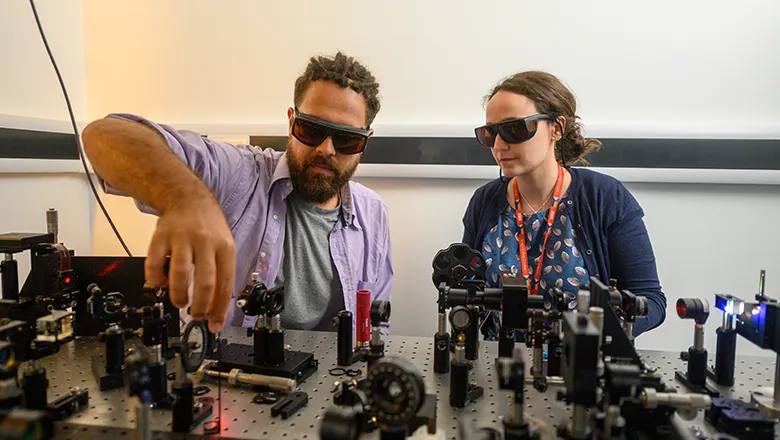"Metamaterials are able to control the propagation of sound, water and light waves...This has enabled the development of technologies such as flat lenses for microscopes and smartphones; and even invisibility cloaks.”
Professor Anatoly Zayats
01 February 2024
King's physicists in £7.7 million grant to develop metamaterials that change their properties in time
Varying the properties of materials at rapid speeds brings the potential to transform fields such as telecommunications, information processing, imaging and quantum technologies.

King’s physicists are part of a new grant to develop materials that change their properties at rapid speeds, enabling greater control over sound and light waves. These metamaterials could transform fields such as telecommunications, information processing, imaging and quantum technologies.
Metamaterials are synthetic materials designed with properties that are usually impossible to find in natural systems. They usually comprise multiple materials that are structured and combined in 2D or 3D, with a spatial structure and geometry that give them unique properties.
King’s lead on the project, Professor Anatoly Zayats, explains, “Metamaterials are able to control the propagation of sound, water and light waves. For example, they can dramatically bend the direction of light in a way not possible with natural optical materials.
“This has enabled the development of technologies such as flat lenses for microscopes and smartphones; and even “invisibility cloaks” to shield noise from aircrafts and busy roads, or protect buildings from the sound and matter waves created by earthquakes."
Funded by the Engineering and Physics Sciences Research Council (EPSRC), the new project - Meta4D - will explore how metamaterials can manipulate waves in time, as well as space. It brings together King’s scientists Professor Anatoly Zayats, Professor Joe Bhaseen and Dr Francisco Rodríguez Fortuño, all from the Department of Physics, with researchers from the University of Exeter and Imperial.
Metamaterials of the future
How a material responds to waves is not only dependent on its chemical and mechanical properties, but also on its microscopic structure. Silver film is used in some antique mirrors to reflect light, but it’s also used in the form of silver particles in old photographs to absorb light waves, resulting in black pigment. The material behaves differently in the two scenarios because of the way the silver itself is structured and distributed in the materials.
Metamaterials take this principle and expand it across the breadth of the electromagnetic spectrum – i.e. the full spectrum of light waves, as well as other forms of waves such as acoustic or vibrational waves. The structure of metamaterials also take shape in much more complex forms than films or small particles.
Materials and metamaterials that can change in time have sought after properties to manipulate acoustic, matter and electromagnetic signals in communications and information processing, imaging and sensing."
Professor Anatoly Zayats
Scientists are now exploring how the fourth dimension - time - can be used in metamaterials. Dr Francisco Rodríguez Fortuño said, “so far we’ve been using space to exert our control over electromagnetic waves, it’s time we use time!”
When a material that a wave is travelling in abruptly changes its properties, a phenomenon known as a time reflection can occur. Spatial reflections occur when a wave hits a boundary in space, which is why you hear echoes as sound bounces off walls or you see your own reflection as light bounces off a mirror.
A wave ‘reflecting in time’ does not change its direction, but instead changes its frequency and energy. Though hypothesised for the past decades, scientists have only recently been able to change the properties of a material at the speeds needed to make this a reality.
The META4D project sees the scientists apply this new discovery to lead the next generation of metamaterials. They will not only be designed to have a specific spatial structure, but also properties that can vary rapidly in time – i.e. changing the properties which control how waves interact with the structure, faster than the speed of a wave’s oscillation.
For a sound wave carrying someone’s voice, that could be hundredths of a second. For a laser, that could be a millionth of a millionth of a second.
Professor Joe Bhaseen said, “It’s an exciting opportunity to develop strong links between theory and experiment in cutting edge metamaterials research involving both space and time”.
The EPSRC grant will fund both theoretical and experimental development of time-modulated metamaterials in close collaboration with industry.
Professor Zayats said , “Materials and metamaterials that can change in time have sought after properties to manipulate acoustic, matter and electromagnetic signals in communications and information processing, imaging and sensing. We are looking forward to working with our industry partners to develop their new applications.”



